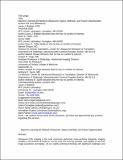Machine learning for medical ultrasound: status, methods, and future opportunities
Author(s)
Brattain, Laura J; Telfer, Brian A; Dhyani, Manish; Grajo, Joseph R; Samir, Anthony E
Download261_2018_1517_ReferencePDF.pdf (948.0Kb)
Publisher Policy
Publisher Policy
Article is made available in accordance with the publisher's policy and may be subject to US copyright law. Please refer to the publisher's site for terms of use.
Terms of use
Metadata
Show full item recordAbstract
Abstract
Ultrasound (US) imaging is the most commonly performed cross-sectional diagnostic imaging modality in the practice of medicine. It is low-cost, non-ionizing, portable, and capable of real-time image acquisition and display. US is a rapidly evolving technology with significant challenges and opportunities. Challenges include high inter- and intra-operator variability and limited image quality control. Tremendous opportunities have arisen in the last decade as a result of exponential growth in available computational power coupled with progressive miniaturization of US devices. As US devices become smaller, enhanced computational capability can contribute significantly to decreasing variability through advanced image processing. In this paper, we review leading machine learning (ML) approaches and research directions in US, with an emphasis on recent ML advances. We also present our outlook on future opportunities for ML techniques to further improve clinical workflow and US-based disease diagnosis and characterization.
Date issued
2018-02-28Department
Lincoln LaboratoryPublisher
Springer US